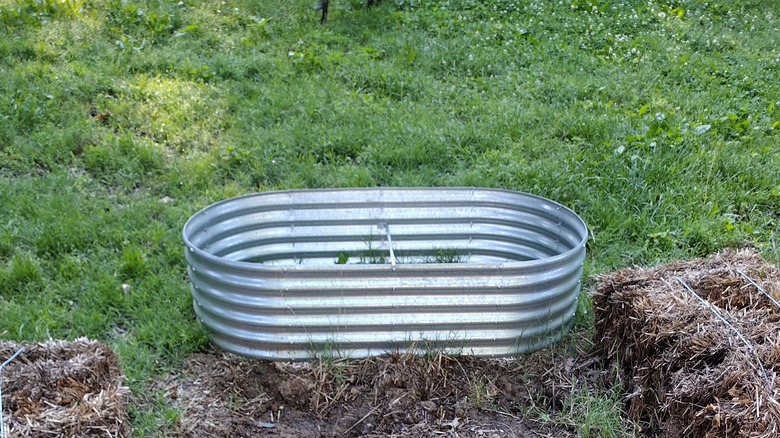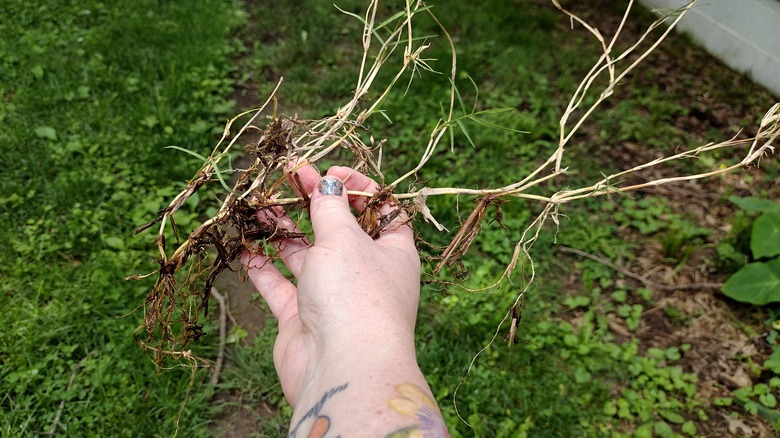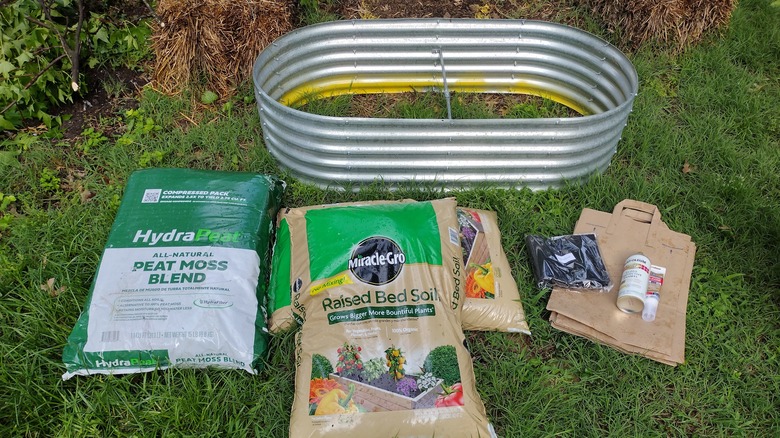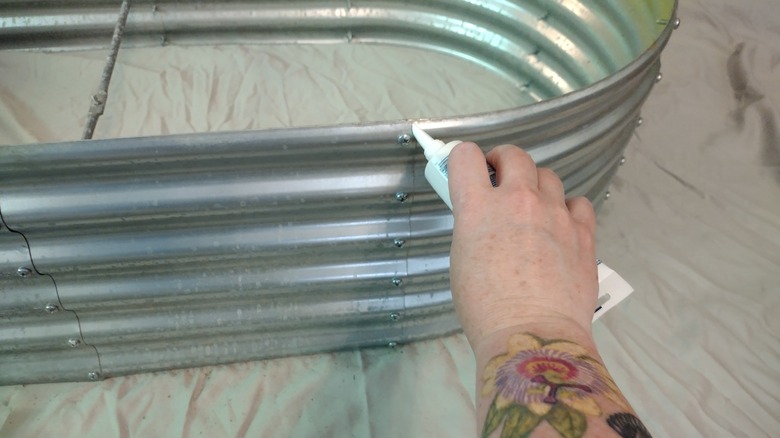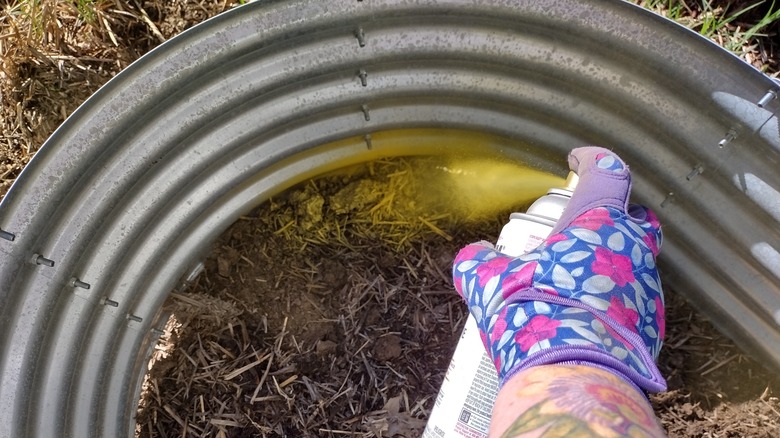We Buried Prefab Raised Beds To Keep Bermuda Grass Out And We Really Dig This DIY
We may receive a commission on purchases made from links.
I have a personal vendetta against Bermuda grass. For over a decade I have tried to keep this invasive grass out of my in-ground garden. Many home gardeners will till areas where Bermuda creeps in or spray it with herbicide, but as a no-till, organic gardener, I removed everything by hand. All that time spent dealing with this pestilent plant helped me understand exactly how it grows and spreads. This knowledge led me to the idea of burying part of my metal raised bed along with a few other interventions.
All soil must be prepped for successful planting, so I prepared for my battle against Bermuda grass last spring when I tried straw bale gardening in the space I wanted to add a raised bed. I was able to get some good harvests from that little garden while it was suffocating the grass and weeds underneath to prepare for something more permanent. After removing the bales this spring, I discovered the soil was dark, loose, nutrient-dense, and free of weeds and grass... for now. Let's see if we can ensure that continues.
Why Bermuda grass is problematic
Before we dive into the "how" of this project, I want to explain the "why." If you have battled Bermuda grass in your landscape or garden beds, you know how frustrating it is when it seems like you've done everything to prevent it. Landscape fabric, mulch, and above-ground edging do little to keep this grass from taking over. While Bermuda grass is not on the National Invasive Plant Species list, it is considered invasive in many states, including Texas and California.
Bermuda grass was imported into the U.S. in the 1800s, most likely from Africa or Southern Asia, and it is easy to care for and grow. The reason this grass is so successful throughout all but the coolest climates in the U.S. is its incredible ability to reproduce and spread. While the seeds of some types of Bermuda grass are viable and can be distributed by wildlife and wind, it is the rhizomes and stolons of this grass that cause the most problems. Once a plant is established, it creates a dense rhizome cluster in the soil that spreads underground in every direction. Each of those runners creates its own plant and rhizome cluster. As if that isn't bad enough, Bermuda also spreads above ground via stolons, which are horizontal stems that take root, producing rhizomes. It is easy to see how Bermuda grass takes over cultivated spaces so quickly.
Supply list for burying prefab raised beds
I tried to think of every step that would work to keep Bermuda from creeping into my raised bed. There are many designs for raised beds, but I started with this simple prefab bed from Amazon, opting for metal instead of wood so it won't rot in the moist ground. It comes in many pieces that have to be screwed together, so I bought a cheap electric screwdriver to speed up the process. Since this is an experiment, I'm starting with a small raised bed that's 2 feet wide, 4 feet long, and 12 inches deep. The metal edges are super sharp, so wear gloves, long sleeves, pants, and shoes when you're putting it together to avoid getting sliced.
The bed I bought included landscape fabric, but since Bermuda will grow through it, I opted for a thick layer of brown paper bags to suffocate any remaining weed seeds. Cardboard would also work.
The secret ingredient in this battle to keep Bermuda from invading is clear silicone sealant made to withstand moisture in kitchens in bathrooms. And, of course, I bought bags of raised garden soil and peat to use as my planting medium once the bed is installed. Not including the plants, the cost for this raised bed was about $90, but if you already have some supplies, your cost could be less. Amazon regularly offers deep discounts on prefab garden beds, so keep an eye out for those.
Preparing the prefab planter to install
Since I'm waging war on Bermuda grass, I know I need to protect my raised bed on multiple fronts. In this experiment, extra preparation is the key. Of course the plan is to bury the bottom part of my aluminum raised bed to keep grass out, but experience has taught me that Bermuda is exceptionally good at squeezing a root rhizome into the tiniest crevice. I don't think I've ever seen a type of grass that is so good at exploiting any weakness in a landscape.
The bed I purchased consists of multiple panels screwed together, which means there are very small gaps between each panel. Even with the bed buried, each connection is an opportunity for a rhizome to enter. To prevent this, I decided to use clear waterproof silicone sealant to close up every gap in the bottom 8 inches all around the bed, which is the portion that will be underground. As I mentioned earlier, those panel edges are sharp so I applied the sealant along the gaps in the panels and used a plastic spoon to force the sealant into every teeny tiny crevice.
Protecting the raised bed from invasive Bermuda grass
With the bed put together and sealed, it was time to put it in the grass-free, weed-free space where my straw bale garden was last year. Since I didn't want to bury this bed more than once, the location had to be perfect the first time. Specifically, I wanted it to look straight when I'm gazing at my beautiful raised garden from my kitchen window. After some adjusting, I was happy with the location, so I used bright yellow spray paint to mark the inside of the bed to use as my guide to dig. Then it was time for the heavy-duty work.
I dug a trench about 6 inches deep around my marked area. This depth works for me because, in my dense clay soil, Bermuda rhizomes only grow 2 to 4 inches below the surface. In loamy or sandy soils, beds would need to be buried a few inches deeper than the rhizomes.
Once I was happy with my bed's position, I backfilled the trench to secure it using some of the soil I dug out. At the bottom of the bed, I placed a few layers of paper bags and topped that with raised bed soil mix and a peat blend to help it retain moisture.
Will burying a prefab metal bed keep Bermuda grass out?
Time will be the true test to see if burying my metal prefab garden bed and sealing all the creases will keep Bermuda grass out for good, but I have high hopes. I know every point of weakness is sealed and my bed is buried about 4 inches below the deepest clusters or rhizomes. That's one benefit of dense soil, I guess! Since I buried my bed 6 inches deep, that only leaves me with a 6-inch tall bed, but that's enough to keep the grass out and make it easy to use the weedeater around. I'm all about keeping my lawn and garden tidy and low-maintenance these days.
Now that I've been through the entire process of planning this project from beginning to end, I've already laid the groundwork to prepare for the next one. I'm using a tarp secured with rocks and topped with that old straw to suffocate the grass and weeds next to this bed. You can be sure I'll be looking for a good sale on metal garden beds!
